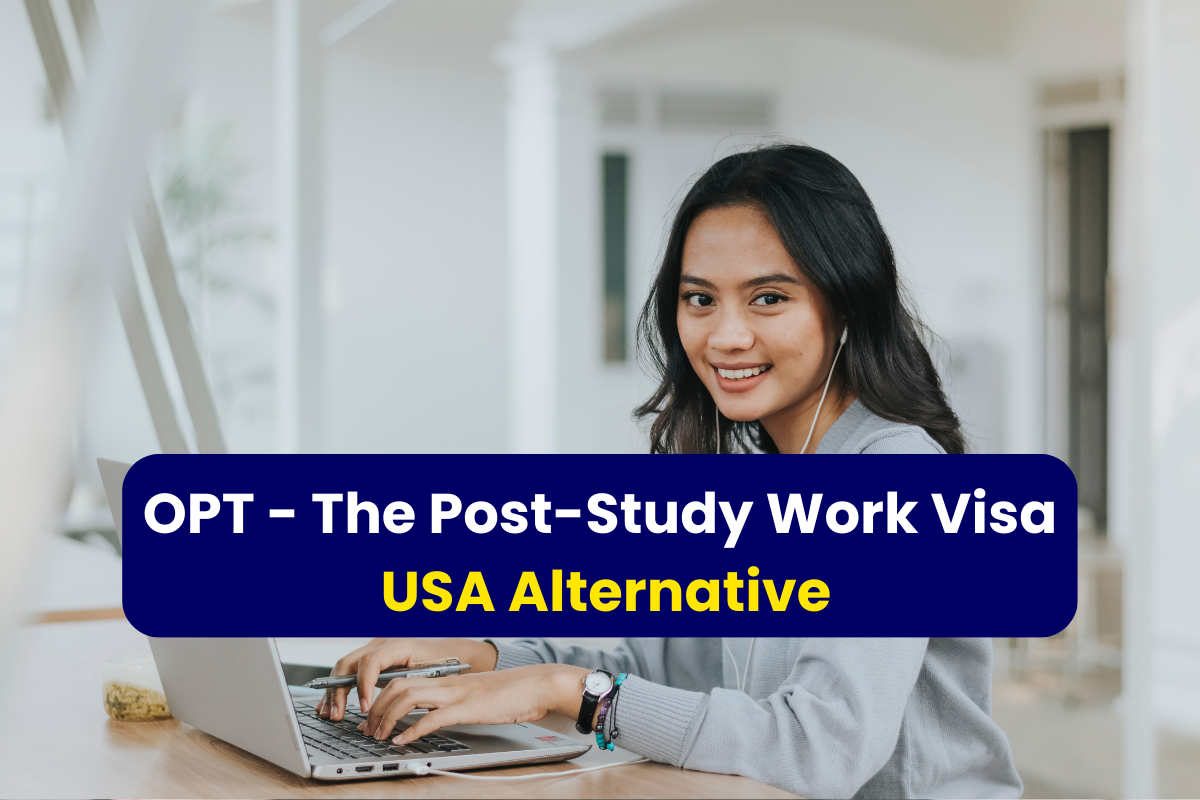OPT - The Post Study Work Visa USA Alternative

Starting a higher education journey is about more than just learning new things; it’s about setting yourself on track for the future. Understanding the post-study options in your study-abroad destination is one of the priorities of many of our students. Which is why we often get the question “Is there a post study work visa the USA offers international students?”
Well – not exactly. But this does not mean you can’t stay and work in the USA after graduation. We break down the F-1 visa, your student work rights in the USA, and why you don’t need a post study visa in the USA.
Understanding the F-1 Visa
So, is there a post study work visa USA edition? The short answer is, “No” – because you don’t need one! Your F-1 student visa allows you – with the right authorization of course – to continue living and working in the USA after graduation.
The F-1 visa is a non-immigrant visa that allows you to study in the United States. You will hold this visa for the duration of your academic program. And as part of your rights as an F-1 visa holder, you can pursue education and gain practical experience in the USA! While the F-1 visa itself does not guarantee post-graduation work authorization, it serves as the starting point for exploring other avenues like Optional Practical Training (OPT).
The Post Study Work Visa USA Alternative
Beyond its reputation for academic standards, the draw of a college education in the US lies in the prospect of career options and professional development.
Many international students hope to get a work visa in the USA after completing their studies, bridging the distance between academic qualification and real-world career opportunities. With your future career in mind, it’s natural to include your work rights and opportunities as a student in your decision of choosing to study in the USA.
Your Work Rights as an International Student in the USA
First things first – part-time work in the USA works differently for international students compared to part-time work in other destinations. With the Subclass 500 visa, for example, you can work up to 48 hours per two weeks in Australia. However, in the USA, international students can only work part-time on campus. To work as an international student in the USA, you have two options:
• Curriculum Practical Training (CPT)
• Optional Practical Training (OPT)
Both CPT and OPT:
• Must relate to the field of your study
• Needs appropriate authorization before you can start working
• Is an option after your first year (international students can’t work off-campus in their first year)
Curricular Practical Training (CPT)
CPT stands for Curricular Practical Training, and it is a type of work authorization for international students in the USA holding an F-1 visa. As you can guess from the name, CPT relates to your curriculum or program. This is training or work experience that is a part of your degree, meaning you need to complete it as part of your course.
CPT allows you to gain practical work experience directly relating to your major field of study to supplement classroom learning.
Here are key points to understand about Curricular Practical Training (CPT):
Authorization for Practical Training:
CPT is exclusively practical training that is an integral part of your curriculum. Similar to co-op programs in Canada, these programs include real-world work professional experience as one of the learning outcomes of your degree.
To qualify for your CPT, you must first get an offer for your training from an employer. Once you have this offer, you need to request the right authorization from your Designated School Official (DSO). Once the DSO finds that you are eligible for CPT, they will authorize you for CPT on SEVIS. This change will also reflect on your Form I-20.
Eligibility:
To be eligible for CPT, you must be enrolled in your academic program for at least one full academic year (excluding language training programs). Exceptions to this requirement exist for graduate students whose programs require immediate participation in practical training.
Types of CPT:
There are two types of CPT: “required” and “optional.”
• Required CPT: Some degree programs mandate practical training as part of the curriculum. These internships are part of your degree requirements or course credit requirements.
• Optional CPT: If practical training is not a mandatory part of the curriculum, you can still participate in optional CPT. However, you must secure a job offer that directly relates to your major field of study.
Duration:
The duration of CPT will depend on the program and course requirements. You can engage in part-time or full-time CPT, but note that you also must be in full-time enrolment as a student during this time. Missing classes because of work can jeopardize your F-1 student status.
Note that if you sign up for 12 months of full-time CPT, you will no longer be eligible for Optional Practical Training (OPT). Post-Completion OPT is the alternative to a post study work visa USA version.
Application Process:
The application process for CPT involves coordination between the academic institution’s designated school official (DSO) and you. The DSO will authorize CPT in your SEVIS (Student and Exchange Visitor Information System) record after you receive a verification letter from your employer and request CPT authorization. Once you have the necessary permissions, you can start working!
Impact on OPT:
Participating in 12 months or more of full-time CPT can impact your eligibility for post-graduation Optional Practical Training (OPT). You need to consider the long-term implications of your practical training choices.
While CPT provides valuable opportunities for gaining practical experience during the academic program, as an international student, you should be mindful of the regulations and work closely with your DSO to comply with these. Each academic institution also has its own policies and procedures regarding CPT, so you should consult your DSO for specific guidance.
Optional Practical Training (OPT)
Rather than needing a “post study work visa USA” like Canada’s Post-Graduation Work Permit or the UK’s Graduate visa, in the USA your post-study option comes under Optional Practical Training (OPT).
Optional Practical Training (OPT), unlike CPT, is not necessary for your program completion. However, as an international student, with the right authorizations it lets you, as an F-1 visa holder, to work in your area of study both during and after your program. If you are majoring in STEM (Science, Technology, Engineering, and Mathematics), you can be eligible for a 24-month post-study extension!
OPT requires your DSO’s approval and must relate to your field of study. Your DSO will recommend you for OPT in SEVIS. You may participate in OPT if the US Citizenship & Immigration Service (USCIS) authorizes you and issues an Employment Authorization Document (EAD).
That is a lot of work and steps and acronyms. To assist you in navigating the challenges of the F-1 student visa, we recommend contacting your university or working with study abroad counselors who specialize in the USA.
To understand why OPT is the alternative to post-study work visas in the USA, let’s break down its two types:
Pre-Completion OPT
This allows you to work part-time while your academic program is ongoing, given you complete at least one full academic year first.
Post-Completion OPT
After completing your studies, you can apply for post-completion OPT as an F-1 student, allowing you to work full-time in a position in your field of study for up to 12 months. Note that the length of your OPT post-study will depend on whether you did CPT and OPT before completing your program.
For students in specific Science, Technology, Engineering, and Mathematics (STEM) fields, you can access a 24-month extension!
Eligibility:
For post-completion OPT, you must apply within 90 days before or 60 days after completing your academic program.
STEM OPT extension requires a timely application, and the student’s employer must be an E-Verify participant.
Application Timeline:
You should plan and gather the necessary documents, including Form I-765 (Application for Employment Authorization), before completing your studies.
Job Search:
You will need to find training that directly relates to your field of study.
STEM OPT Extension
The STEM OPT extension is a significant advantage for international students graduating in specific STEM fields. To qualify for the extension, you must work for an employer participating in the E-Verify program and the job must directly relate to your STEM degree. The extension not only more valuable time to gain practical experience but also improves your chances of securing employment opportunities in the highly competitive global job market.
Validity of the OPT
OPT is valid for 12 months, at all study levels. Note that this is a total of both pre- and post-completion OPT. So, if you complete 6 months of pre-completion OPT, you will only be able to qualify for post-completion OPT for 6 months. If you complete 12 months of pre-completion OPT, you won’t qualify for Post-Completion OPT. And as we discussed earlier, if you complete 12 months of full-time CPT, you no longer qualify for OPT.
OPT Extension
If you are studying specific STEM degree programs, you may be eligible for a 24-month OPT extension. You can look into which fields this extension applies to via the US Department of Homeland Security’s STEM OPT Hub.
Rounding Up
The ability to work and enhance career opportunities is at the forefront of most students’ minds. We hope that we not only answered the “Is there a post study work visa USA” question but broke down all the employment opportunities you can consider as an international student. Remember that as an F-1 student visa holder, you have certain obligations to upkeep to maintain your student status. Whether you are considering CPT or OPT, be sure to adhere to the proper steps and conditions. If you’re ever in doubt, your Designated School Official (DSO) is there to help you out!


